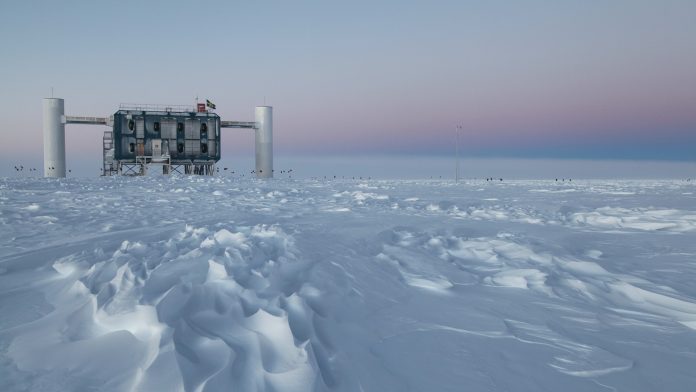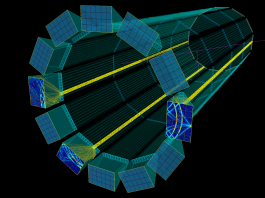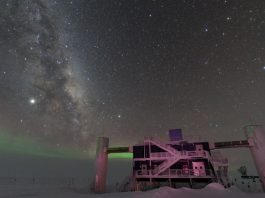Professor Aya Ishihara from Chiba University and Professor Albrecht Karle from the University of Wisconsin-Madison explore the progression from IceCube to IceCube-Gen2 and its pivotal role in the expanding field of neutrino astronomy.
Neutrinos are fundamental particles that traverse the cosmos with minimal interaction, providing a unique window into the Universe’s most energetic and distant phenomena.
The IceCube Neutrino Observatory¹ (see Fig. 1), the world’s first cubic-kilometre, high-energy neutrino telescope, has offered a new perspective on the nonthermal Universe, detecting neutrinos with energies from a few TeV to well over 10,000 TeV. For comparison, the highest energy particle beam at the Large Hadron Collider (LHC) is 6.8 TeV.
By detecting cosmic neutrinos, IceCube has provided groundbreaking insights into high-energy cosmic events and their connection to cosmic rays – energetic particles that travel through space, the origins of which have long remained elusive. IceCube’s notable achievements include observing a steady flux of high-energy neutrinos linked to ultra-high-energy cosmic rays, revealing an intriguing relationship between these phenomena. Remarkably, the total energy carried by cosmic neutrinos is comparable to that of cosmic rays and gamma rays.
IceCube’s discoveries – such as the identification of the blazar TXS 0506+056,² the Seyfert galaxy NGC 1068,³ and the Galactic plane⁴ as sources of high-energy neutrinos – demonstrate the potential of neutrino astronomy to unravel the Universe’s most intense processes. One striking example is NGC 1068, where neutrinos are detected without accompanying gamma rays. This absence suggests that neutrino production occurs near the supermassive black hole at the galaxy’s centre, offering new insights into the extreme environments surrounding black holes. In such dense regions, gamma rays interact with the surrounding matter, losing energy in the process, whereas high-energy neutrinos can escape, preserving their energy and providing a clearer picture of the underlying mechanisms.
IceCube-Gen2: Pushing the boundaries of neutrino detection
Building on IceCube’s pioneering work, IceCube-Gen2 is set to redefine the limits of neutrino detection and broaden our observational capabilities. This next-generation neutrino telescope will bring several major enhancements, including an expanded optical array, as well as a large-scale radio array and a surface array, as shown in Fig. 2. Together, these components will significantly enhance our ability to detect and study high-energy neutrinos, offering a more comprehensive view of the Universe’s most energetic processes.
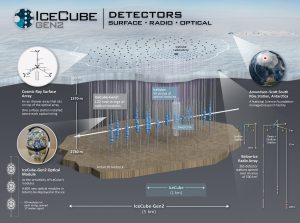
Exploring new neutrino sources
While IceCube has successfully identified various astrophysical sources emitting neutrinos, its sensitivity limitations have confined observations primarily to sources with high luminosity. This often corresponds to a lower concentration of sources in the local Universe, or relatively rare objects, consistent with the overall distribution of astrophysical neutrinos in the Universe as observed by IceCube.
Although IceCube’s findings are only the tip of the iceberg, they have placed stringent constraints on other high-luminosity sources, such as blazars and gamma-ray bursts, contributing to the diffuse neutrino flux. This suggests that the main contributors are likely sources with lower brightness but a greater abundance (higher number density), including low-luminosity active galactic nuclei (AGN), galaxy clusters, and starburst galaxies, along with transient sources such as supernovae.
IceCube-Gen2, with its enhanced sensitivity, is designed to address these limitations, specifically our current restriction to observing only rare and high-luminosity sources. By expanding the array and integrating advanced technologies, IceCube-Gen2 will achieve a sensitivity of at least five times greater than IceCube, enabling the detection of a broader range of neutrino-emitting sources. Fig. 3 illustrates the anticipated discovery potential for different neutrino source classes based on their luminosity density and overall luminosity.
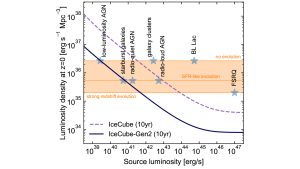
including those from sources too distant or faint to be individually detected, as observed by IceCube under different redshift evolution hypotheses. IceCube-Gen2 will have the capability to scan across a range of candidate source classes. Credit: IceCube Collaboration
Moreover, IceCube-Gen2 will provide significant improvements in detecting transient sources. The upgraded detector will be capable of identifying smaller neutrino flares than those observed from sources like TXS 0506+056. For brighter sources, it will enable more precise measurements of neutrino emission spectra and time variations, offering crucial insights into the spectral shape of neutrino emissions and the acceleration processes occurring in these sources. Additionally, IceCube-Gen2’s reach extends beyond astrophysics, offering unique opportunities in particle physics by probing energy ranges unattainable by manmade accelerators and on cosmic-scale baselines. In geophysics, it will provide insights into the ice-sheet dynamics and the bedrock beneath, making it a powerful tool for diverse, multidisciplinary scientific breakthroughs.
Enhanced detection capabilities of 8km³ of new photon detectors
The optical array of IceCube-Gen2 represents a major technological leap. The volume will expand from 1km³ to 8km³ by increasing the spacing between optical sensors. Approximately 10,000 new optical sensors will be deployed, with horizontal spacing increased to 240m – up from 125m in IceCube. The depth coverage of the sensors will also be increased by about 300m to a depth of 2,690m.
The larger array size will enhance detection sensitivity for point sources by a factor of five and increase the number of contained events by almost an order of magnitude, resulting in more precise measurements of neutrino sources and high statistics of events at energies above 30 TeV. The track lengths of neutrino-induced muons will more than double compared to IceCube, leading to more than a factor of two improvement in angular resolution. This enhancement is essential for accurately identifying and characterising neutrino sources.
Advancements in optical modules for IceCube-Gen2
The new optical modules, covering a fiducial volume of about 8km³ (including the existing 1km³ of the IceCube array), feature advanced four-inch photomultiplier tubes (PMTs) housed in 12.5-inch pressure vessels, as illustrated in the lower-left window of Fig. 2. Conical silicone gel pads, precast and filled during assembly, optimise optical coupling to maximise photon collection. This design also reduces cost and weight while efficiently managing power constraints at the Amundsen-Scott South Pole Station.
These optical modules are built to withstand the harsh conditions of the South Pole, functioning effectively at temperatures as low as -40 degrees and pressures up to 70 MPa. Prototype testing has confirmed their performance and structural integrity under extreme conditions. With these advanced optical modules, IceCube-Gen2 will achieve a fourfold increase in sensitivity per module compared to its predecessor, improving event statistics and angular resolution. This will provide a more detailed and comprehensive view of high-energy astrophysical phenomena.
Expanding observational reach with radio and surface arrays
IceCube-Gen2 introduces significant advancements with its new radio and surface arrays, extending the observational capabilities of the original IceCube detector. The large-scale radio array is designed to detect ultra-high-energy neutrinos via the Askaryan effect, where radio waves are emitted by particle showers generated from neutrino interactions within the ice. This array will cover a vast volume and operate between 100-600MHz – the frequency range where the Askaryan signal is most prominent. By expanding our observational range, the radio array will enable the study of the highest energy neutrinos, surpassing current detection limits.
IceCube has contributed substantially to understanding cosmic ray origins and has placed essential constraints on theoretical models of cosmic neutrino production. The IceTop surface detector has been crucial in measuring secondary particles from cosmic rays, aiding our comprehension of cosmic-ray composition and energy. IceCube-Gen2’s surface array upgrades will build on these achievements. The enhanced surface array will provide refined measurements of cosmic rays and their interactions. This upgrade will advance our understanding of cosmic-ray anisotropy and energy spectra, providing more precise insights into the origins of cosmic rays and their role in the high-energy Universe.
Overcoming challenges of construction at the South Pole
Building a cubic-kilometre-scale neutrino detector in one of the most remote locations on Earth – the South Pole – was a daunting task. However, the success of IceCube demonstrates that such an endeavour was not only possible but has proven highly rewarding. IceCube established the method of rapid hot water drilling of large holes and deployed 20 or more strings of sensors per field season at a depth of 2,500m. With the valuable lessons learned from constructing IceCube, we are well prepared to tackle the challenges of building IceCube-Gen2. Effective logistical support will be crucial to the project’s success.
The US Antarctic Program provides impressive logistical support capabilities, including:
- Cargo: A big challenge is the transport of fuel and cargo to the South Pole. An initial analysis⁵ suggests that all fuel and a large fraction of cargo can be transported across the ice sheet via the South Pole Traverse (see Fig. 4). This efficient overland transport method has significantly improved logistical capabilities at the South Pole. It can offset the reduced air capacity.
- Population: An additional population of 60 personnel will be required at the South Pole during the summer months, from November to early February; temporary summer housing is a practical solution. This approach has been used effectively, accommodating up to 280 people during peak construction periods, 130 more than the nominal housing in the main South Pole station building.
- Power: Since the station’s power plant will be modernised as part of the infrastructure modernisation at the South Pole, there is an opportunity to plan for the addition of future projects. In full operation, IceCube-Gen2 will require an estimated 100 kW of power. However, this demand will exceed the station’s current capacity only after approximately five years of construction, allowing sufficient time to plan and implement the necessary power upgrades.

Discussions about infrastructure maintenance and upgrades at the South Pole station are ongoing. We believe it is essential to continue scientific activities and not defer them until after these upgrades. By closely co-ordinating with the broader scientific community and ensuring logistical support is factored into project budgets, we can maintain scientific progress while improving the station’s infrastructure.
The South Pole remains a critical hub for scientific discovery, hosting a wide range of experiments – from geoscience to astroparticle physics – that explore the Universe in ways uniquely possible from this location. IceCube-Gen2 will contribute to this vibrant scientific community and enhance our understanding of the unseen Universe.
Looking ahead
IceCube-Gen2 represents a transition from the discovery of cosmic neutrinos (IceCube) to the broader field of neutrino astronomy. It is poised to significantly enhance our understanding of the high-energy Universe and uncover new insights into its most energetic processes, as detailed in the Technical Design Report (TDR).⁵ Key milestones include the installation of the IceCube Upgrade in the 2025/2026 season,⁶ which features seven new densely instrumented strings of optical modules. The continued development of IceCube-Gen2 will mark a new era in neutrino astronomy. By expanding its observational reach and sensitivity, IceCube-Gen2 will build on IceCube’s achievements, opening new avenues for exploring the Universe’s most energetic phenomena and advancing our knowledge of high-energy neutrinos and cosmic rays.
References
- M.G. Aartsen et al. (IceCube), JINST 12 P03012 (2017).
- M.G. Aartsen et al. (IceCube), Science 361 (2018), 147-151
- R. Abbasi et al. (IceCube), Science 378 (2022), 538-543
- R. Abbasi et al. (IceCube), Science 380 (2023), 1338-1343
- IceCube-Gen2 Technical Design Report (IceCube-Gen2),
https://icecube-gen2.wisc.edu/science/publications/tdr/ - Summer Blot and Albrecht Karle,
https://www.innovationnewsnetwork.com/paving-the-way-for-next-generation-neutrino-discovery/30370/ (2023)
Please note, this article will also appear in the 20th edition of our quarterly publication.

